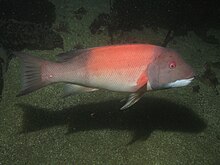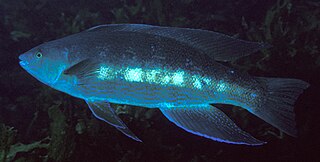
The Odacidae are a small family of ray-finned fishes formerly classified within the order Perciformes, commonly known as cales, and weed whitings. They are related to the much larger families of the wrasses and parrotfish. More recent workers have classified this family within the order Labriformes, alongside the wrasses and parrotfishes, within the clade Percomorpha.

Coris is a genus of wrasses, collectively known as the rainbow wrasses, found in the Atlantic, Indian, and Pacific Oceans.

Pseudolabrus is a genus of wrasses native to the eastern Indian Ocean and the Pacific Ocean.

Suezichthys is a genus of wrasses native to the southeastern Atlantic Ocean through the Indian Ocean to the Pacific Ocean.
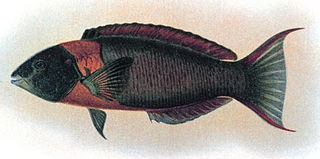
Thalassoma is a genus of wrasses native to the Atlantic, Indian and Pacific Oceans.

Labrus is a genus of wrasses native to the eastern Atlantic Ocean into the Mediterranean and Black seas.
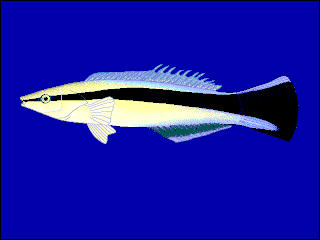
Labroides is a genus of wrasses native to the Indian and Pacific Oceans. This genus is collectively known as cleaner wrasses, and its species are cleaner fish.

Symphodus is a genus of wrasses native to the eastern Atlantic Ocean and the Mediterranean Sea.

Gomphosus is a small genus of wrasses native to the Indian and Pacific Oceans.

Hemigymnus is a genus of wrasses native to the Indian and Pacific oceans.

Hologymnosus is a genus of wrasses native to the Indian Ocean and the western Pacific Ocean.

Iniistius is a genus of wrasses native to the Indian and Pacific Oceans.
Lappanella is a genus of wrasses native to the eastern Atlantic Ocean and the Mediterranean Sea.
Leptojulis is a genus of wrasses native to the Indian Ocean and the western Pacific Ocean.
Malapterus reticulatus is a species of wrasse endemic to the Juan Fernández Islands in the southeastern Pacific Ocean. It is a cleaner of species in the genus Scorpis, eating the isopod ectoparasites in their mouths. This species is the only known member of its genus. It is found in shallow, coastal waters over rocky reefs.

Pictilabrus is a genus of wrasses endemic to the eastern Indian Ocean waters of Australia.

Polylepion is a genus of wrasses native to the Pacific Ocean. It is also known as a bleeding wrasse. They are mostly found over sandy waters from Mexico to Nicaragua, including Cocos Island.
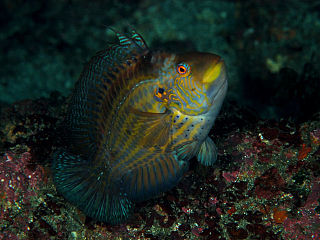
Pteragogus is a genus of wrasses native to the Indian Ocean and the western Pacific Ocean.

Pseudolabrus eoethinus, the red naped wrasse, is a species of marine ray-finned fish from the wrasse family, Labridae. It is found in the northwestern Pacific off the coast of Japan, Taiwan and in the South China Sea.. This small species of wrasee, with a standard length of up to 207 millimetres (8.1 in), which is common on rocky reefs, in waters no deeper than 30 metres (98 ft). This species lives in small harems made up of a single territorial male and a number of females. Spawning takes place from mid-November to mid-December with the fish pairing up and spawning within the male's territory. P. eoethinus associates with the morwong Goniistius zonatus, feeding mainly on crustaceans and molluscs. This species was first formally described as Labrus eoethinus by the Scottish naturalist and naval surgeon John Richardson (1787-1865) in 1846 with the type locality given as Canton, China. Previously, Coenraad Jacob Temminck & Hermann Schlegel applied the name Labrus rubiginosus to specimens they examined but this name was invalid although Pieter Bleeker used this name for the Type species of his new genus, Pseudolabrus in 1862.

Stethojulis strigiventer, also known as the three-ribbon wrasse, silverstreak wrasse, silverbelly wrasse, lined rainbowfish or silver-streaked rainbowfish, is a species of marine ray-finned fish, a wrasse from the family Labridae. This species occurs in beds of seagrass and areas of inner reefs and shallow lagoons where there is a substrate consisting of mixed sand, rubble, and algae. It is found in small groups which swim over large areas down as deep as 20 metres (66 ft). The range of this species extends from the Red Sea southwards along the eastern coast of Africa to Algoa Bay in KwaZulu-Natal, South Africa and eastwards to the Marshall and Tuamotu islands, it also extends north to Honshu and south to New South Wales. This species was first formally described as Julis strigiventer in 1833 by the English zoologist Edward Turner Bennett (1797-1836) with the type locality given as Mauritius. When Albert Günther created the genus Stethojulis he designated Julis strigiventer as the type species.
